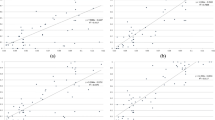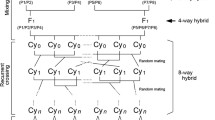Abstract
The aim of this study was to explore, by computer simulation, the mapping of QTLs in a realistic but complex situation of many (linked) QTLs with different effects, and to compare two QTL mapping methods. A novel method to dissect genetic variation on multiple chromosomes using molecular markers in backcross and F2 populations derived from inbred lines was suggested, and its properties tested using simulations. The rationale for this sequential testing method was to explicitly test for alternative genetic models. The method consists of a series of four basic statistical tests to decide whether variance was due to a single QTL, two QTLs, multiple QTLs, or polygenes, starting with a test to detect genetic variance associated with a particular chromosome. The method was able to distinguish between different QTL configurations, in that the probability to `detect' the correct model was high, varying from 0.75 to 1. For example, for a backcross population of 200 and an overall heritability of 50%, in 78% of replicates a polygenic model was detected when that was the underlying true model. To test the method for multiple chromosomes, QTLs were simulated on 10 chromosomes, following a geometric series of allele effects, assuming positive alleles were in coupling in the founder lines For these simulations, the sequential testing method was compared to the established Multiple QTL Mapping (MQM) method. For a backcross population of 400 individuals, power to detect genetic variance was low with both methods when the heritability was 0.40. For example, the power to detect genetic variation on a chromosome on which 6 QTLs explained 12.6% of the genetic variance, was less than 60% for both methods. For a large heritability (0.90), the power of MQM to detect genetic variance and to dissect QTL configurations was generally better, due to the simultaneous fitting of markers on all chromosomes. It is concluded that when testing different QTL configurations on a single chromosome using the sequential testing procedure, regions of other chromosomes which explain a significant amount of variation should be fitted in the model of analysis. This study reinforces the need for large experiments in plants and other species if the aim of a genome scan is to dissect quantitative genetic variation.
Similar content being viewed by others
References
de Koning DJ, Visscher PM, Knott SA, Haley CS: Strategies for QTL detection in halfsib populations. Anim Sci 67: 257–268 (1998).
Gimelfarb A, Lande R: Simulation ofmarker assisted selection in hybrid populations. Genet Res 63: 39–47 (1994).
Haley CS, Knott SA: A simple regression method for mapping quantitative trait loci in line crosses using flanking markers. Heredity 69: 315–324 (1992).
Jansen RC: Interval mapping of multiple quantitative trait loci. Genetics 135: 205–211 (1993).
Jansen RC: Controlling the type I and type II errors in mapping quantitative trait loci. Genetics 138: 871–881 (1994).
Jansen RC, Stam P: High resolution of quantitative traits into multiple loci via interval mapping. Genetics 136: 1447–1455 (1994).
Kearsey MJ, Hyne V: QTL analysis: a simple 'marker regression' approach. Theor Appl Genet 89: 698–702 (1994).
Keightley PD, Ohnishi O: EMS induced polygenic mutation rates for nine quantitative Characters in Drosophila melanogaster. Genetics 148: 753–766 (1998).
Knott SA, Neale DB, Sewell MM, Haley CS: Multiple marker mapping of quantitative trait loci in an outbred pedigree of loblolly pine. Theor Appl Genet 94: 810–820 (1997).
Knott SA, Marklund L, Haley CS, Andersson K, Davies W et al.: Multiple marker mapping of quantitative trait loci in an outbred cross between wild boar and Large White pigs. Genetics 149: 1069–1080 (1998).
Lande R 1981: The minimum number of genes contributing to quantitative variation between and within populations. Genetics 99: 541–553 (1981).
Lande R, Thompson R. Efficiency of marker assisted selection in the improvement of quantitative traits. Genetics 24: 743–756 (1990).
Mackay TFC: The genetic basis of quantitative variation: numbers of sensory bristles of Drosophila melanogaster as amodel system. Trends Genet 11: 464–470 (1995).
Shrimpton AE, Robertson A. The isolation of polygenic factors controlling bristle score in Drosophila melanogaster. I. Allocation of third chromosome sternopleural bristle effects to chromosome sections. Genetics 118: 437–443 (1988).
Shrimpton AE, Robertson A. The isolation of polygenic factors controlling bristle score in Drosophila melanogaster. II. Distribution of third chromosome bristle effects within chromosome sections. Genetics 118: 445–459 (1988).
van Ooijen JW: Accuracy of mapping quantitative trait loci in autogamous species. Theor Appl Genet 84: 803–811 (1992).
Visscher PM: Proportion of the variation in genetic composition in backcrossing programs explained by genetic markers. J Hered 87:136–138 (1996).
Visscher PM, Haley CS: Detection of putative quantitative trait loci in line crosses under infinitesimal genetic models. Theor Appl Genet 93: 691–702 (1996).
Visscher PM, Haley CS: Power of a chromosomal test to detect genetic variation using genetic markers. Heredity 81: 317–326 (1998).
Whittaker JC, Thompson R, Visscher PM: On the mapping of QTL by regression of phenotype on marker-type. Heredity 77: 23–32 (1996).
Wu WR, Li WM: Model fitting and model testing in the method of joint mapping of quantitative trait loci. Theor Appl Genet 92: 477–482 (1996).
Zeng ZB: Theoretical basis for separation of multiple linked gene effects in mapping quantitative trait loci. Proc Natl Acad Sci USA 90:10972–10976 (1993).
Zeng ZB: Precision of quantitative trait loci. Genetics 136: 1457–1468 (1994).
Author information
Authors and Affiliations
Rights and permissions
About this article
Cite this article
Visscher, P., Whittaker, J. & Jansen, R. Mapping multiple QTL of different effects: comparison of a simple sequential testing strategy and multiple QTL mapping. Molecular Breeding 6, 11–24 (2000). https://doi.org/10.1023/A:1009612308004
Issue Date:
DOI: https://doi.org/10.1023/A:1009612308004




